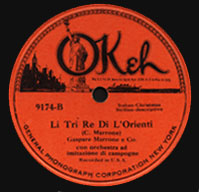|
The second piece included here, also taken from the 78 rpm record production, was cut in the United States in 1924 and comes into that strand of production that was called “ethnic”, indeed reserved to the different ethnic groups of immigrants. This is the Li tri re di l’orienti (The three Magi from Orient), written by Gaspare Marrone, performed by G. Marrone & Co.
The text, known of in hundreds of variants in Sicily and elsewhere, tells of the arrival of the Wise Men in Bethlehem and the offering of the gifts to the Baby Jesus. It draws inspiration from the story of the birth of Jesus as told by the evangelist Matthew (Mt 2, 1-12) and even more by the apocryphal Gospels of Infancy (Armenian Gospel of the Childhood 14-22; Arab-Syriac Gospel VII; Proto-Gospel of James XXI, 3; Pseudo-Mathew XVI, 1-2). From the latter we learn the names and the number of the Magi, their status as Kings and we come to know of “miraculous” facts that happened in coincidence with the birth. But it is above all in the Arab and Armenian drafts of these Gospels that we find a great wealth of fable-like elements, as we can find in the popular songs, for all of the narration of the birth and the childhood of Jesus. From the metric point of view we are faced with, as for the previous piece, quatrains of hendecasyllables, even if often we find a certain irregularity probably due to the modifications that the text has undergone over time. This document appears to be particularly interesting from the actual performance perspective. It is a recital, following precise rhythmic and intonation rules, typical of the Sicilian cuntastorie. Even the cuntastorie, like the blind ballad singers, were helped by the protection of the Church as early as the 16th and 17th centuries, and like the orbi were often subjected to it. They came from the masses and brought to the people nuvene, trionfi and cunti, operating in the name of a religious truth that, only in its origin, was provided by the canonical authority. Story-tellers, both true and fictitious, fortifying or shocking for their contents or the morals they conveyed, the cuntastorie went all around the cities, moving from one part of Sicily to another, they would attend the homes of private citizens, squares, feasts, markets, any situation that allowed for the presence of a potentially fee-paying audience (see Buttitta 1960, Burgaretta 1989, Pasqualino 1992) [2]. The capacity to dramatise and to make the word “visual” makes it possible for the figure of the cuntastorie to develop rapidly in Sicily, and reach the height of its popularity by the end of the 19th century. A tradition that was still alive, at least until the first half of the 20th century, today the cuntu is only history, something that practically disappeared some years ago, together with one of the last great cuntastorie, Fortunato Giordano, who came from Palermo (see Giordano 1991). |
